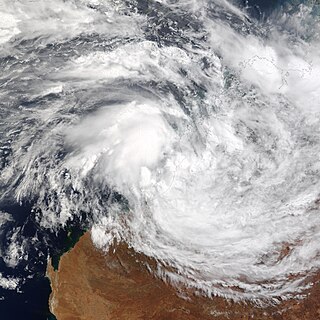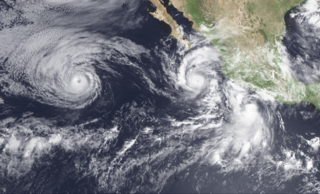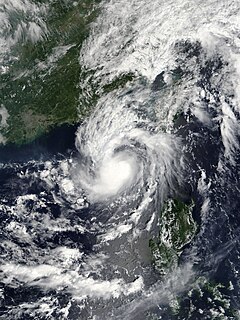
The 2006 Pacific typhoon season was a below-average season that produced a total of 23 named storms, 15 typhoons, and six super typhoons. The season ran throughout 2006, though most tropical cyclones typically develop between May and October. The season's first named storm, Chanchu, developed on May 9, while the season's last named storm, Trami, dissipated on December 20. Also, this season was more active, costly, and deadly than the previous season.

The 1996 Pacific typhoon season has no official bounds; it ran year-round in 1996, but most tropical cyclones tend to form in the northwestern Pacific Ocean between May and November. These dates conventionally delimit the period of each year when most tropical cyclones form in the northwestern Pacific Ocean.

Tropical Storm Vamei was a Pacific tropical cyclone that formed closer to the equator than any other tropical cyclone on record. The last storm of the 2001 Pacific typhoon season, Vamei developed on 26 December at 1.4° N in the South China Sea. It strengthened quickly and made landfall along extreme southeastern Peninsular Malaysia. Vamei rapidly weakened into a remnant low over Sumatra on 28 December, and the remnants eventually re-organized in the North Indian Ocean. Afterward, the storm encountered strong wind shear once again, and dissipated on 1 January 2002.

Cyclone Graham of the 2002–03 Australian region cyclone season was a weak tropical storm that affected Australia during late February and early March 2003. Graham originated from an area of convection that emerged onto water after sitting over Australia on 23 February. The interaction with a monsoon trough formed an area of low pressure that developed into Tropical Cyclone Graham on 27 February. The storm moved slowly to the east-southeast, and after turning to the south it peaked as a tropical storm and made landfall on Western Australia the next day. The cyclone weakened as it moved inland, and dissipated on 1 March. The storm dropped heavy rainfall and caused high winds, which produced flooding and downed trees. One fatality occurred, though no significant damages were reported.

The 1989–90 Australian region cyclone season was an above average tropical cyclone season. It was also an event in the ongoing cycle of tropical cyclone formation. It ran from 1 November 1989 to 30 April 1990. The regional tropical cyclone operational plan also defines a tropical cyclone year separately from a tropical cyclone season, and the "tropical cyclone year" ran from 1 July 1989 to 30 June 1990.

The 1978–79 Australian region cyclone season was the only season in which a reconnaissance aircraft flew into a tropical cyclone. Operationally, Australia's Bureau of Meteorology (BOM) tracked eleven tropical cyclones, while two additional systems were later added to the United States's Joint Typhoon Warning Center (JTWC) best track. Prior to 1985, the Australian region basin was defined as in the southern hemisphere between 80°E and 160°E, with the modern day season boundaries ranging from 1 November to 30 April of the following year. The first storm, an unnamed system, developed on 19 November 1978. The final cyclone, Kevin, dissipated by 12 May 1979. Tropical cyclones in this area were monitored by three Tropical Cyclone Warning Centres (TCWCs): the BOM in Perth, Darwin, and Brisbane.

Typhoon Joan was an intense typhoon that caused minor damages in relative to the strength of the typhoon. Joan was the strongest typhoon of 1959 Pacific typhoon season, and one of the most intense Pacific typhoons on record. Joan formed from a surface center to the northeast of Guam on August 23, in which Japan Meteorological Agency began to track and classify the system as a tropical depression on the next day. A reconnaissance aircraft was sent to investigate the surface center and in 03:25 UTC on August 25 the surface center was classified as a tropical storm by Joint Typhoon Warning Center. The storm rapidly intensified into a typhoon in the same day it was formed. By the next three days as Joan tracks towards Taiwan, Joan explosively intensified to attain peak intensity with the pressure of 885 millibars (26.1 inHg), which is tied with Nina as the most intense Pacific typhoon on the record at the time. Shortly afterwards, Joan attained peak strength as a Category 5 equivalent typhoon on the Saffir–Simpson hurricane scale with winds of 165 knots (190 mph) before making landfall in Taiwan as a 160 knots (180 mph) typhoon, which was according to JTWC is the strongest landfall in the recorded history at the time. After making landfall, Joan weakened into a 110 knots (130 mph) typhoon before making landfall on Fujian, China as a Category 2 equivalent typhoon on the Saffir–Simpson hurricane scale with winds of 95 knots (109 mph). Once onshore, Joan did not degenerate quickly as Joan remained as a tropical cyclone for about one day before transitioning into a extratropical cyclone in 18:00 UTC of August 31. Extratropical remnants of Joan quickly traversed through South Korea and Japan before being last noted on 18:00 UTC, September 2.

The 2021 Pacific typhoon season is an ongoing event in the annual cycle of tropical cyclone formation, in which tropical cyclones form in the western Pacific Ocean. The season runs throughout 2021, with no seasonal boundaries, though most tropical cyclones typically develop between May and October. The season's first named storm, Dujuan, developed on February 16. The season's first typhoon, Surigae, reached typhoon status on April 16. It became the first super typhoon of the year on the next day, also becoming the strongest tropical cyclone in 2021. Surigae was also the most powerful tropical cyclone on record in the Northern Hemisphere for the month of April. Typhoons In-fa and Rai are responsible for more than half of the total damage this season, adding up to a combined total of $1.720 billion.

The 2021 North Indian Ocean cyclone season is an ongoing event in the annual cycle of tropical cyclone formation. The North Indian Ocean cyclone season has no official bounds, but cyclones tend to form between April and December, peaking between May to November. These dates conventionally delimit the period of each year when most tropical cyclones form in the northern Indian Ocean.

Tropical Storm Pabuk, also referred to as Cyclonic Storm Pabuk, was a weak storm that struck the Malay Peninsula in January 2019. It was also the earliest-forming storm in both the Northwestern Pacific Ocean and North Indian Ocean basins on record. Forming on the last day of 2018, Pabuk persisted into 2019, spanning two calendar years, and crossed into the North Indian Ocean basin several days later. The first tropical cyclone and named storm of the 2019 Pacific typhoon and North Indian Ocean cyclone seasons, Pabuk originated as a tropical disturbance in the South China Sea on December 28, 2018, which organized into a tropical depression on December 31. A day later, on January 1, 2019, the system intensified into a tropical storm and was named Pabuk. Pabuk made landfall in Thailand on January 4, emerging into the Bay of Bengal in the North Indian Ocean basin shortly afterward. Pabuk weakened after it entered the North Indian Ocean, eventually degenerating into a remnant low on January 7, before dissipating on the next day.

During 1993, tropical cyclones formed within seven different bodies of water called basins. To date, 110 tropical cyclones formed, of which 78 were given names by various weather agencies. Only one Category 5 tropical cyclone was formed in 1993.

Typhoon Saudel, known in the Philippines as Typhoon Pepito, was a typhoon which affected the Philippines, Vietnam and Southern China in October 2020. The seventeenth tropical storm and seventh typhoon of the 2020 Pacific typhoon season, Saudel formed from a tropical disturbance east of the Philippines. The disturbance gradually organized and crossed the Philippines as a tropical storm. Once the system emerged into the South China Sea, it began to rapidly organize and intensify, becoming a typhoon early on October 22.

Tropical Storm Krovanh, known in the Philippines as Tropical Depression Vicky, was a tropical cyclone which caused deadly flooding in the Philippines during December 2020. The 31st depression and 23rd and final named storm of the 2020 Pacific typhoon season, Krovanh originated from a tropical depression which was first monitored by PAGASA, late on December 17. The system strengthened with PAGASA naming it Vicky, meanwhile the JMA monitored it as a low pressure area. The depression then made several landfalls over the Philippines on December 18–19 before moving out of the PAR on December 20, as it strengthened into a tropical storm according to the JMA and was named Krovanh. However, Krovanh was downgraded back to a tropical depression the next day, with the JTWC issuing their final advisory on December 22.

Tropical Storm Barijat, known in the Philippines as Tropical Storm Neneng, was a weak tropical storm that caused flooding in the far northern regions of the Philippines and Southern China. The thirty-third tropical depression and twenty-third tropical storm of the 2018 Pacific typhoon season, it was first noted as an area of convection in the South China Sea on September 6. On September 8, it was upgraded to a tropical depression, and by September 11, it intensified into a tropical storm, with the Japan Meteorological Agency (JMA) giving it the name Barijat. Barijat peaked in intensity 6 hours later, with 10-min winds of 40 knots and 1-min winds of 45 knots. Barijat continued westward, and on November 12 at 00:30 UTC, it made landfall over Zhanjiang, quickly dissipating afterwards.

Tropical Storm Dawn was a weak tropical cyclone that caused 187 deaths in Vietnam, and was described as the worst storm to hit the region in 3 decades. The 27th tropical depression and 13th named storm of the 1998 Pacific typhoon season, Dawn formed from a monsoon trough in the South China Sea on November 16. The same day at 18:00 UTC, the Japan Meteorological Agency (JMA) assessed that it had become a tropical depression. The depression continued organizing, and on November 18 at 18:00 UTC, the Joint Typhoon Warning Center (JTWC) upgraded the depression to a tropical storm, giving it the name Dawn. Dawn peaked 1-minute sustained winds of 45 knots before making landfall near Cam Ranh, moving inland and quickly dissipating.

Typhoon Kyle, known in the Philippines as Typhoon Luring, was the first of five deadly tropical cyclones that affected and impacted the Philippines and Vietnam during the 1993 Pacific typhoon season. Being the twenty-seventh named storm and thirteenth typhoon of the season, Kyle formed from a monsoon depression near Palau, associated with bursts of scattered convection. It then drifted west-northwest, strengthening to a tropical storm the next day. Land interaction prevented further intensification, and it crossed through the central Philippines while maintaining its intensity on November 20. Upon entering the South China Sea, the system strengthened to a severe tropical storm before rapidly intensifying to a typhoon, three days later. It soon reached its peak intensity that day, with one-minute maximum sustained winds of 175 km/h (110 mph), equivalent to a mid-level Category 2 typhoon. It held its strength until landfall in Vietnam later that evening. Weakening through the mountainous terrain of the country, it dissipated near the Cambodia–Thailand border on November 24.

Typhoon Manny, known in the Philippines as Typhoon Naning, was a deadly, long-lived, and unusual tropical cyclone that did a considerable loop before hitting the country during early-December 1993. It was also the second typhoon to hit the Visayas that year, following Kyle. Being the twenty-ninth named storm and fifteenth typhoon of the 1993 Pacific typhoon season, the system formed from a near-equatorial trough that also spawned Lola during the month in the east Caroline Islands on December 3. Moving northwestwards, it strengthened to a tropical storm on the next day before intensifying further to a severe tropical storm that night. The system attained typhoon status on December 8 as it underwent a clockwise loop, nearly the same as Pamela, 11 years later. It then rapidly intensified while moving to the southwest, with the typhoon reaching its peak of 220 km/h (140 mph) and an unusually high barometric pressure of 960 mbar before crossing the central Philippines on December 10 and 11. It soon moved through the South China Sea as a tropical storm before weakening to a tropical depression as it encountered high wind shear. However, it restrengthened back to a tropical storm as it moved back again to a favorable environment before passing to the south of Vietnam as the system weakened back below gale-force winds. It then dissipated on December 16 as it passed through Thailand.
Tropical Cyclone Audrey, also referred to by other media as Little Audrey, was a strong tropical cyclone that caused flooding and destruction on its path, from Queensland to New South Wales during early-to-mid January 1964. Audrey was first noted as a developing disturbance to the west of Moa Island in the Gulf of Carpentaria on January 7; however, the system formed a day prior. It moved east, passing to the north of Thursday Island before heading southeast, making a clockwise loop while making landfall in the Cape York Peninsula before strengthening to a Category 1 tropical cyclone, with the Bureau of Meteorology naming it Audrey. It moved south-southwestwards while slowly intensifying, becoming a Category 2 tropical cyclone before making landfall at Mornington Island on January 11. Land interaction degraded Audrey; however, it remained below severe tropical cyclone intensity until it made a second landfall on Gangalidda, Queensland on that day before weakening inland. However, the present-day brown ocean effect prevented Audrey from weakening as it progressed through the eastern Northern Territory before degrading to a Category 1 tropical cyclone as it turned southeastwards, drifting through southern Queensland before entering New South Wales on the afternoon of January 14 as it slowed down. Extratropical transition took place as Audrey restrengthened to a Category 2 tropical cyclone while drifting southeastwards, becoming fully extratropical as it emerged through the Coral Sea near Coffs Harbour on that day. It then brushed North Island of New Zealand as an extratropical storm before dissipating on January 16 in the Southern Pacific Ocean.

Tropical Storm Koguma was a weak tropical cyclone that made landfall in Vietnam, causing minor damage. The fourth named storm of the 2021 Pacific typhoon season, the system was first noted as an area of persistent convection on the South China Sea on June 10, with the JTWC assessing the system in its first advisory as a monsoon depression. Tracking west-northwestwards, marginally conductive environmental conditions in the area allowed slight intensification while drifting towards Hainan Island. On the next day, the JMA upgraded the system to a tropical depression as it passed to the south of the territory before the agency upgraded the system to a tropical storm on June 12, being assigned the name Koguma. The JTWC; however still treated the system as a tropical depression until 12:00 UTC that day. It continued to move northwest over the warm waters of the Gulf of Tonkin, eventually making landfall in Vietnam over Thanh Hóa by the end of the same day, rapidly weakening afterward.

Malaysia is a country in the southern part of Southeast Asia and is located to the south of the South China Sea. The sea separates two regions which consists of Peninsular Malaysia, located within the Malay Peninsula, and East Malaysia, located within the island of Borneo.




















